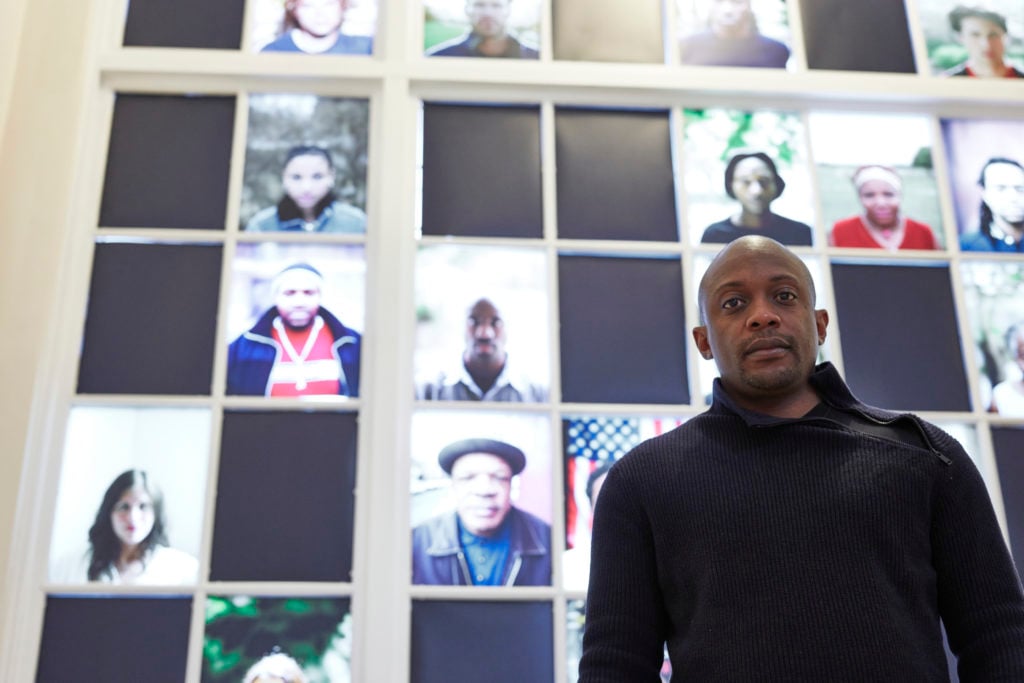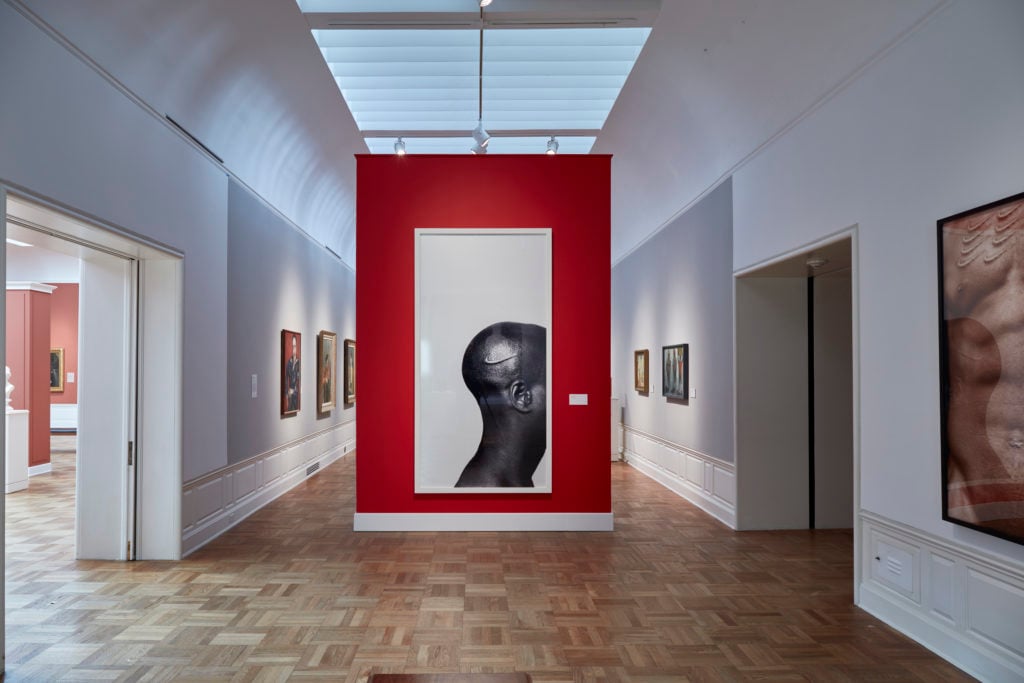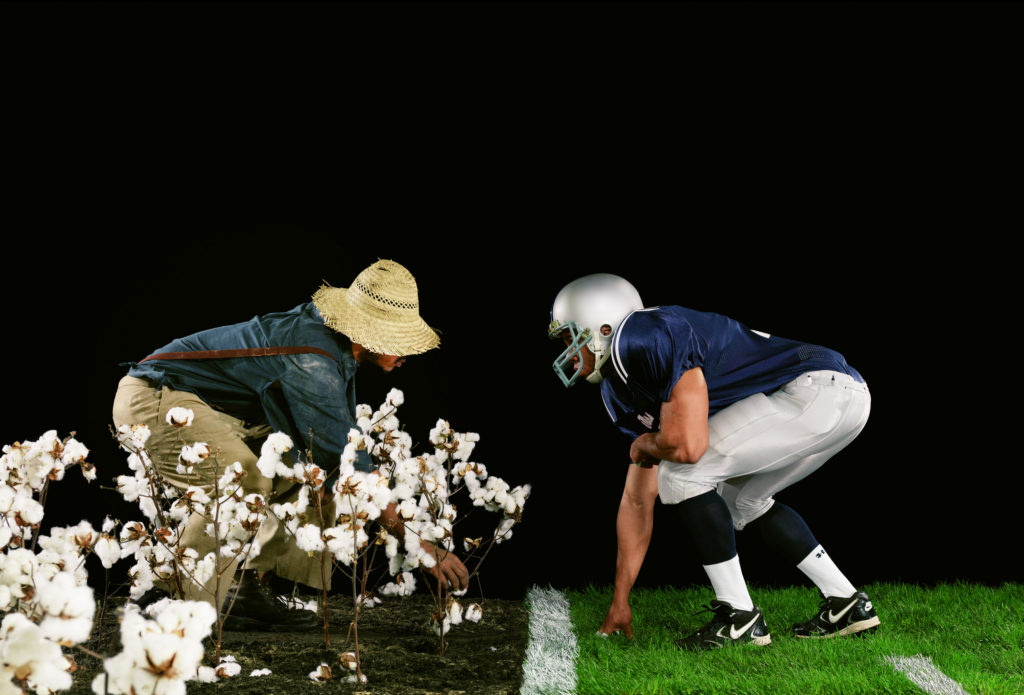On View
Hank Willis Thomas’s New Portland Art Museum Show Exposes the Manipulative Power of Advertising in the City Where Nike Was Born
The artist hopes that Nike adverting executives will make time to visit the exhibition.

The artist hopes that Nike adverting executives will make time to visit the exhibition.

Rachel Corbett

For the artist Hank Willis Thomas, one of the highlights of having his mid-career survey at the Portland Art Museum is that it’s in the same city as the headquarters of Nike.
Thomas has long been influenced, and seemingly troubled, by the effects of the company’s branding, elements of which appear throughout his work. In fact, the show’s promotional banner hanging from the Oregon museum’s facade features Thomas’s 2003 photograph of a black man’s head, branded with the Nike swoosh logo.
Years before Colin Kaepernick took a knee and ignited the sports industry’s intensely politicized new era, Thomas was making work about the plight of college athletes like his cousin Songha Willis, one of the many young men who “spend their whole life trying to get this opportunity, and then there could be an injury, or a life-altering decision about where to go, and the school and everyone’s making money but the players,” Thomas told artnet News.

Hank Willis Thomas’s Branded Head (2003) at the Portland Art Museum.
The sports industry’s exploitation of African American labor is a dynamic that recurs throughout the exhibition. Thomas compares it explicitly to slavery in photographs like those of a sneaker chained to a basketball, or a football player crouching across a yard line from a cotton picker, or a player dunking a basketball into a noose.
Despite the apparent condemnation in much of Thomas’s sports-influenced work, the artist considers himself a fan of Nike’s ads, which are created largely by the Portland-based agency Weiden and Kennedy. “I got to tour their offices and the Nike offices,” he said. “It was really cool.”
Thomas admires the potency of advertising, if not always its ends. “I grew up in what they call the ‘MTV Generation,’ and I realized then that advertising is a completely powerful language, but it’s usually a one-way language,” he said. Companies use it “only to get us to buy something, but there’s not as much use of that language to talk about other issues.”

Hank Willis Thomas, The Cotton Bowl (2011). Image courtesy of the artist and Jack Shainman Gallery, New York. © Hank Willis Thomas.
Thomas decided he wanted to use this form of messaging to “sell ideas, rather than just be driven by product.” In 2016, he and fellow artist Eric Gottesman formed the For Freedoms Super PAC. But instead of raising money for a political candidate, they generated artist-designed advertising, such as billboards by Marilyn Minter, Rashid Johnson, and others that appeared in all 50 US states during the midterm elections of 2018.
For Freedoms is currently in the process of transitioning from a political action committee to a nonprofit, but it will still be active during the 2020 elections. Its plans are yet to be determined, but Thomas said that “we want to do a different version of the 50-state initiative in 2020. Hopefully it’ll include billboards.”
The Thomas survey in Portland will travel to the Crystal Bridges Museum of American Art in Arkansas and the Cincinnati Art Museum in Ohio. But before it does, Thomas hopes that some of the Portland area’s advertisers will be able to pay a visit.

Hank Willis Thomas’s Guernica (2016) is made from cut-up and restitched sports jerseys. Courtesy of the Portland Art Museum.
“Being that my work is so influenced by Nike and Apple advertising, and Weiden and Kennedy—the company that kind of opened all those doors in all our minds, setting the gold standard—it’s exciting that people from those companies will be influenced by my work,” he said.
He pointed to a print in the show that features, in lenticular optical-illusion text, the phrase “ART IMITATES LIFE IMITATES ADS IMITATES ART” and said, “it’s a vicious cycle of art directors and graphic designers coming to museums to be inspired by art and then filtering that into the ads that they make and filtering [those] into the world to imitate.”
“Hank Willis Thomas: All Things Being Equal…” is on view through January 12, 2020, at the Portland Art Museum.